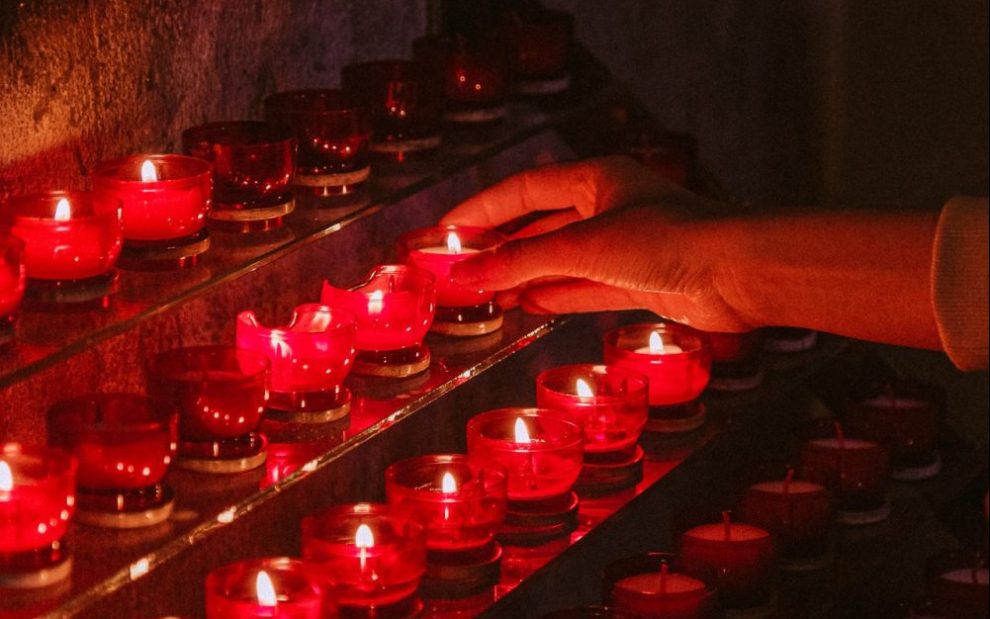My mom kept a plastic bottle of holy water by the front door of our home and another on the bureau in my parents’ bedroom. Every day she would use the water to mark a cross on our foreheads before going to Sunday Mass, school, play, and work. At night, before kissing us good night, she would again bless us. When other kids would come over, no matter what their religion, they too would be blessed. Occasionally she would sprinkle the water on the floor and pray that it would “cool the soles of the poor souls in purgatory”—a blessing she learned from my Irish grandmother. After ordination, no matter where I lived in the archdiocese, I would visit my parents for Sunday dinner and ask my mom to bless me as I returned to my parish.
Mom was also fond of lighting candles. Every Monday night, we would go as a family to the Miraculous Medal Shrine to recite novena prayers to Mary and to light candles. Mom would light seven candles, one for my dad and the others for her six children. Today, when I travel home to Philadelphia, I continue to visit the shrine to light candles, including one for her. At home, she lit candles before statues of Mary and St. Thérèse of Lisieux. These candles were for special intentions: safety for my dad as a city fireman and good grades on school exams for my siblings and me. Occasionally, when facing a difficult situation, I pray in my heart, “Mom, light a candle for me today.” The candles are symbolic of God’s presence embodying or enfolding the intention. Nowadays, I light a candle each night as a reminder of God’s nearness through the darkness of the hours.
The touch of water and flickering of a flame are icons of presence and blessing: God’s presence and the love with which the blessing is given and shared. Over the years these icons have germinated within my spirit and sought their own expression in my life.
In my December 2021 The Examined Life column, I wrote of the stuttering that was present in my younger years. As a young priest, knowing that I lacked the skills to be a good preacher and was not an athlete in any sense of the word, I identified with St. Paul who describes himself as lacking in many skills (1 Cor. 4) but is there for the people. He brings other gifts to the table; he is present. He tries to approach people where they are at. He describes himself as a “fool,” as “weak,” as working with his own hands, as responding with a “spirit of gentleness.” These are the blessings he brings to the people of his day.
In my first assignment as a priest, I visited a poorer section of the parish community. Of course, I was nervous because, besides taking a census of the parish, the visit incorporated a collection. With the parents and children gathered in the living room of a Philadelphia rowhouse, I offered to bless the home before I went to the next house. One dad said to me, “Father, we don’t need your blessing. I bless my home and my family by the work of my hands.” I was stunned. I responded, “That’s beautiful!” And I learned that blessings come in a variety of ways.
That day I learned that I didn’t have to be a great preacher. I didn’t have to be the cool, young priest who played sports. I could be present. I attended every sport that our children played: hundreds of basketball games, track meets, cheerleading tournaments, and more. I was at every dance, whether it was a middle school dance or local farmers doing the chicken dance together.
Whenever I received a dinner invitation, I went without questioning what I would find. When a couple married outside the church law, I was present to support and offered a private prayer for their future.
This all didn’t happen at once. It took years to learn how to be present. But by being present, I symbolically light candles and bless those around me, and they me.
This article also appears in the February 2022 issue of U.S. Catholic (Vol. 87, No. 2, page 7). Click here to subscribe to the magazine.
Image: Pexels/Anna Shvets












Add comment